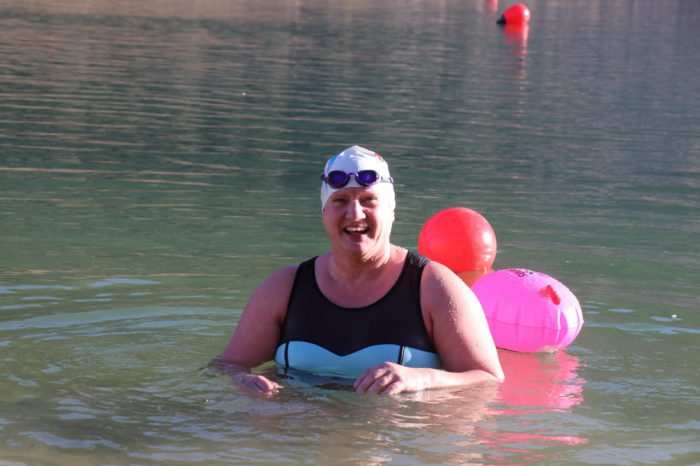Our sponsored swimmer, Cath Pendleton, regularly participates in ice swimming events all over the country. But what exactly is ice swimming? We caught up with Cath to ask her some of the big questions on what, to most people, seems like a crazy concept!
1) So what is ice swimming and how did you get started?
Ice swimming is an extreme sport in which you complete swims of set lengths in water under that is under 5°c. While taking part, competitors are only allowed to wear standard swimming costumes/trunks, a swim cap, and goggles (the rules are the same for anyone attempting to complete a channel swim). There are very strict medical and safety rules that have to be adhered too – it takes several years of training to acclimatise your body to these extreme temperatures.
I got into Ice Swimming in September 2015 after seeing an advert for a Winter Swimming Gala called Chill Swim which was set to take place in Windermere in February 2016. On seeing the advert I thought that it was an exciting idea and would be a great new challenge. Having taken part in triathlons for a number of years, I had recently injured my back and, therefore, would no longer be able to take part in such a physically challenging sport. A couple of friends and I decided to go for it, since I really needed a new focus.
Soon I was completely addicted to ice swimming and in January 2016 became the first Welsh woman to swim an Ice Mile – swimming a mile in water under 5°c wearing just a standard costume, hat, and goggles. I must point out that it is very unusual to complete an ice mile in your first winter season. Many swimmers take 2-3yrs or more to get to this stage. I think ice swimming is possibly in my blood as I spent every summer of my childhood in the local river and loved outdoor pursuits in the winter!
At the end of this winter, I completed my 5th Ice Mile and alongside my friend Viki, I am the first to complete an Ice Mile in the 4 nations: Wales, Ireland, England, and Scotland. Next winter I hope to go on and complete the 6 nations with a swim in Italy and France. I would also love to complete a swim in Morocco to tick Africa off my list and take me one step closer to my dream of completing the Ice Sevens Challenge.
2) How do you avoid hypothermia?
You have to acclimatise to the cold temperatures and this takes time. As the temperature drops after the summer, just keep swimming and your body will gradually get used to the cold. However, you must listen to your body and know your limits. As the temperature drops, you need to begin to decrease the amount of time you spend in the water. The best advice I could give is to not stay in the water for too long and build up time safely. Watch out for clawed fingers or decreasing stroke rate as this is a sign that you have been in too long – really you want to be getting out before such signs appear. Some winter and ice swimmers often only swim for one or two minutes at a time.
It is really important that when you get out you get dressed as quickly as possible. The rush of adrenaline will make you feel warm for a few minutes after you get out. However, you should immediately strip off, rub yourself down and get as dry as you can and dressed before you start shivering. This shivering period is known as the after-drop. The colder the water and the longer you have been in, the more you will experience an after-drop of your core temperature (the effect of cooled peripheral blood returning to the core and/or the warm core rewarming the periphery). This after-drop brings on deep shivering which is actually a positive response of the body to mild hypothermia – it means that your body is reacting naturally to warm you up.
However, the extreme shivering does make putting your clothes on a lot more difficult! It’s therefore really important that all of your clothes are laid out ready to get changed into as quickly as possible. You will need lots of warm layers, a hat, gloves, a warm coat or a dry robe. Once dressed it’s time to get a warm drink and some food inside you. This part for me is a great time to socialise with your ice swimming buddies, sometimes laughing at our shivers, chattering teeth, and spilt drinks.”
3) How do you find places to swim?
When I started ice swimming my friends and I went mainly to rivers we knew. However, sometimes they were not suitable to swim in after heavy rain so we would go to the sea. Unfortunately, the temperature is usually too warm in the autumn to use it to train in for ice swimming. This meant we had to look for alternative lakes, ponds, etc. This is not easy as a lot of them do not allow swimming other than during organised events.
I, therefore, turned to social media for open water and wild swimming groups to get some new ideas. There is a good Facebook group called South Wales Outdoor Swimming which is useful for finding buddies to swim with. There is also a great open-air lido in Portishead that stays open at the weekends in the winter and is unheated. Another relatively local option is Clevedon Marine Lake, which is a popular winter swimming spot. They also have a Facebook group where people post when they are swimming to buddy up, etc.
4) Is it dangerous?
Yes, it can be if you’re inexperienced. You need to be aware of the dangers of Cold Shock and Hypothermia. Know about after-drop and how to recover safely. It can be a number of hours after completing your swim that you are fully recovered so you need to be careful during this time. There are a number of conditions that mean you should seek advice from a doctor before even considering ice swimming. These include things such as heart conditions, high blood pressure, asthma or being pregnant. Always swim sober, and avoid cold water if you have a hangover.
Know how to Swim Safe – where to swim safely and what to do if something goes wrong. There is a wealth of information out there on the web and in books. I would suggest attending an organised information session about Winter/Ice swimming. I attended an event at Portishead Lido, which was really informative and invaluable when I first started out back in 2015. There is a lot of information available on the internet; I started my research with this very useful site.
5) Is it good for you?
Personally, I love it and it really helps my mental and physical well-being. I can become quite grumpy if I have not had my winter/cold water swimming fix! There is a lot of research being done on the benefits of winter swimming. You will see many articles that state some of the benefits are:
- Boosts your immune system
- Gives you an endorphin high
- Enhances your circulation
- Increases your libido
- Burns more calories
- Reduces stress
Find out more about Cath’s latest challenge..









